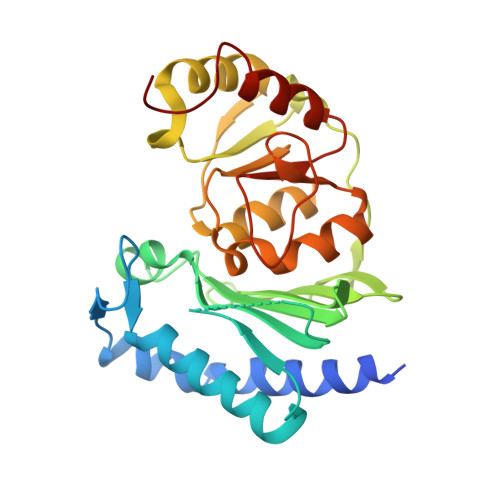Crystal structure of Staphylococcal dual specific inositol monophosphatase/NADP(H) phosphatase (SAS2203) delineates the molecular basis of substrate specificity
Bhattacharyya, S., Dutta, D., Saha, B., Ghosh, A.K., Das, A.K.(2012) Biochimie 94: 879-890
- PubMed: 22197784
- DOI: https://doi.org/10.1016/j.biochi.2011.12.007
- Primary Citation of Related Structures:
3QMF, 3RYD - PubMed Abstract:
Inositol monophosphatase (IMPase) family of proteins are Mg(2+) activated Li(+) inhibited class of ubiquitous enzymes with promiscuous substrate specificity. Herein, the molecular basis of IMPase substrate specificity is delineated by comparative crystal structural analysis of a Staphylococcal dual specific IMPase/NADP(H) phosphatase (SaIMPase - I) with other IMPases of different substrate compatibility, empowered by in silico docking and Escherichia coli SuhB mutagenesis analysis. Unlike its eubacterial and eukaryotic NADP(H) non-hydrolyzing counterparts, the composite structure of SaIMPase - I active site pocket exhibits high structural resemblance with archaeal NADP(H) hydrolyzing dual specific IMPase/FBPase. The large and shallow SaIMPase - I active site cleft efficiently accommodate large incoming substrates like NADP(H), and therefore, justifies the eminent NADP(H) phosphatase activity of SaIMPase - I. Compared to other NADP(H) non-hydrolyzing IMPases, the profound difference in active site topology as well as the unique NADP(H) recognition capability of SaIMPase - I stems from the differential length and orientation of a distant helix ¦Á4 (in human and bovine ¦Á5) and its preceding loop. We identified the length of ¦Á4 and its preceding loop as the most crucial factor that regulates IMPase substrate specificity by employing a size exclusion mechanism. Hence, in SaIMPase - I, the substrate promiscuity is a gain of function by trimming the length of ¦Á4 and its preceding loop, compared to other NADP(H) non-hydrolyzing IMPases. This study thus provides a biochemical - structural framework revealing the length and orientation of ¦Á4 and its preceding loop as the predisposing factor for the determination of IMPase substrate specificity.
Organizational Affiliation:
Department of Biotechnology, Indian Institute of Technology Kharagpur, Kharagpur 721302, West Bengal, India.















